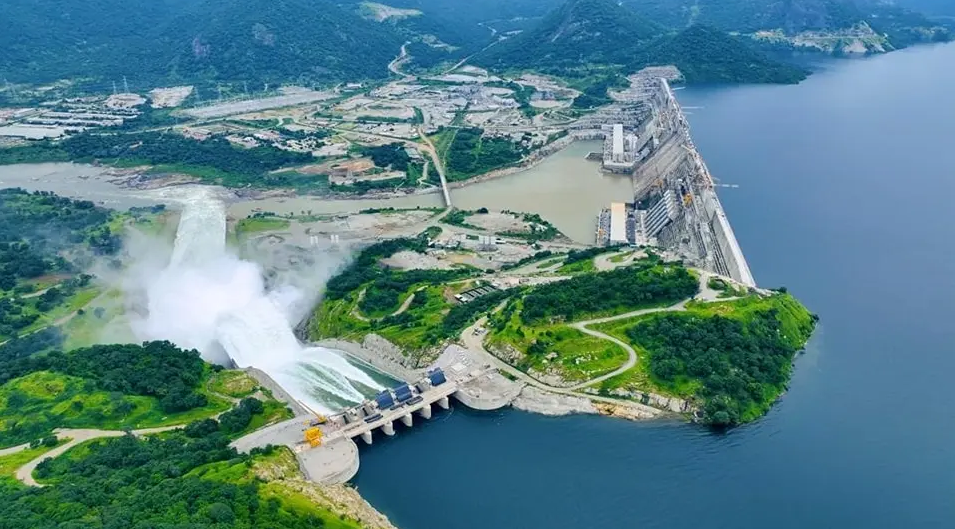GERD—Powering a Nation, Inspiring a Continent - ENA English
GERD—Powering a Nation, Inspiring a Continent

By Girma Mirgisa
In 2011, a dream took root on the banks of the Blue Nile; a dream so audacious, so improbable, that skeptics dismissed it as fantasy. But to millions of Ethiopians, it was not only possible; it was personal. The Grand Ethiopian Renaissance Dam (GERD) began not as a blueprint on paper, but as a spark of hope in the hearts of ordinary people. It was a vision forged not in corporate boardrooms or foreign banks, but in the glow of kerosene lamps and the dusty courtyards of rural homes.
I was a university student at the time, and I remember my childhood in Nono Sekala, a remote village in Oromia, where electricity was an unheard-of luxury. I studied by the dim, smoky light of a kerosene lamp; my dreams of education clouded by the literal and symbolic darkness of energy poverty. One evening, my father said something that would shape my life:
“One day, you will have light. But to reach that day, we must all give what we can to help build the Renaissance Dam.”
He had just heard a radio broadcast urging Ethiopians to contribute. I was still a teenager then, but I managed to find 50 birr and donated it proudly. That 50 birr felt as significant as a thousand, not due to its financial worth, but because of what it symbolized: faith.
Thanks to my family’s support, I was able to complete my education and pursue a career in journalism, dedicated to writing and sharing the stories behind this historic mega-dam. As a young adult, I purchased GERD bonds three times and eventually had the opportunity to visit the dam many times in person.
A People's Dam: Unity in Action
The Grand Ethiopian Renaissance Dam was never just an energy project. It became a national movement one of sacrifice, unity, and defiance. No international loans or other forms of financial supports were involved. Farmers, teachers, laborers, merchants, students, and diaspora communities all gave what they could. Bonds were bought, songs were sung, and hope became a national currency.
Many doubted us. Financial institutions pulled out. Pundits scoffed at the idea of a low-income nation constructing one of Africa’s largest hydroelectric dams. But they underestimated one powerful force: the collective will of the Ethiopian people.
GERD now spans the mighty Abbay River (Blue Nile), standing as one of the most significant infrastructure achievements on the continent. It has already begun to light homes, power industries, and most importantly ignite a sense of ownership and pride in millions.
GERD is not just about electricity; it is about transformation. Over 600 million people in Africa still live without power. GERD challenges that reality by providing clean, renewable energy not only to Ethiopia, but also to neighboring countries such as Sudan, Djibouti, and Kenya. It turns a river once seen as a source of tension into a current of cooperation and shared growth. This is energy diplomacy in motion an interconnected Africa driven by shared prosperity, not foreign dependence.
Green Power, Bold Future
In a world battling climate change, GERD stands as a rare example of sustainability born from necessity rather than abundance. Ethiopia, one of the countries least responsible for global emissions, is choosing to lead the green transition. By replacing carbon-intensive fuels with hydropower, GERD reduces emissions, protects forests, and promotes environmental resilience.
Rural households once dependent on firewood now have access to clean electricity. Women and children no longer spend hours collecting fuel. GERD, through clean energy, is reshaping not only the environment but also daily life, gender roles, and opportunity.
It aligns with global climate goals, including the Paris Agreement and the UN Sustainable Development Goals; particularly SDG 7 (Affordable and Clean Energy) and SDG 13 (Climate Action); positioning Ethiopia not just as a recipient of aid, but as a leader in climate action.
Africa’s Vision in Action
GERD is not a solitary achievement; it is a continental signal flare. It embodies the ambitions of Agenda 2063, the African Union’s blueprint for a prosperous, integrated, and self-reliant Africa. It speaks the language of this vision: homegrown solutions, infrastructure-led growth, and pan-African cooperation.
As African nations work together to build railways, digital corridors, and industrial zones, GERD offers a model for what self-financed, people-powered mega-projects can achieve. It proves that Africa can finance its dreams not with debt, but with determination.
From the African Continental Free Trade Area (AfCFTA) to cross-border energy trading, the continent is weaving itself into a stronger, more resilient whole. GERD stands as a cornerstone in this architecture.
The Grand Ethiopian Renaissance Dam is more than a feat of engineering; it is a monument to belief. It is a symbol of what is possible when people; no matter their means; unite behind a common purpose.
Every drop of water that flows through its turbines whispers back to those smoky nights in villages like mine. Every spark of light it generates is a tribute to the millions who chose hope over doubt and action over despair.
Reflecting on my journey—from a boy squinting under the dim glow of a flickering flame to a journalist standing in the shadow of a monumental dam—I am now privileged to tell the story of the Grand Ethiopian Renaissance Dam. What lies before me is more than a network of power lines and transformers. As it nears full operational capacity and approaches its final ribbon closure, the GERD stands tall as a sovereign landmark—an enduring testament to Ethiopia’s unwavering commitment to self-reliance, unity, and the pursuit of transformative national development.
GERD is my story. It’s Ethiopia’s story. It’s Africa’s story.